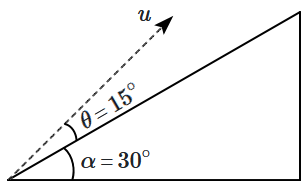A particle is projected with a speed of \(2~\text{m/s}\) from the base of a plane inclined at \(30^\circ\) to the horizontal. The direction of projection makes an angle of \(15^\circ\) above the inclined plane as shown in the figure. If \(g=10~\text{m/s}^2,\) what is the distance along the plane from the point of projection to the point where the particle strikes the plane?

| 1. | \(14~\text{cm}\) | 2. | \(28~\text{cm}\) |
| 3. | \(20~\text{cm}\) | 4. | \(36~\text{cm}\) |
A shell is fired from a fixed artillery gun with an initial speed \(u\) such that it hits the target on the ground at a distance \(R\) from it. If \(t_1\) and \(t_2\) are the values of the time taken by it to hit the target in two possible ways, the product \(t_1t_2\) is:
1. \(\frac{2R}{g}\)
2. \(\frac{R}{2g}\)
3. \(\frac{R}{g}\)
4. \(\frac{R}{4g}\)
The trajectory of a projectile near the surface of the earth is given as \(y=2x-9x^2\). If it were launched at an angle \(\theta_0\) with speed \(v_0\) then:\(\left(g= 10~\text{ms}^{-2}\right)\)
| 1. | \(\theta_0=\cos^{-1}\left(\frac{1}{\sqrt{5}}\right) \text{ and }v_0=\frac{5}{3}~\text{ms}^{-1}\) |
| 2. | \(\theta_0=\cos^{-1}\left(\frac{2}{\sqrt{5}}\right) \text{ and }v_0=\frac{3}{5}~\text{ms}^{-1}\) |
| 3. | \(\theta_0=\sin^{-1}\left(\frac{2}{\sqrt{5}}\right) \text{ and }v_0=\frac{3}{5}~\text{ms}^{-1}\) |
| 4. | \(\theta_0=\sin^{-1}\left(\frac{1}{\sqrt{5}}\right) \text{ and }v_0=\frac{5}{3}~\text{ms}^{-1}\) |
Two particles are projected from the same point with the same speed \(u,\) but at different angles. They both cover the same horizontal range \(R,\) but reach different maximum heights, \(h_1\) and \(h_2.\) Which of the following relations is correct?
| 1. | \(R^2=h_1h_2\) | 2. | \(R^2=16h_1h_2\) |
| 3. | \(R^2=4h_1h_2\) | 4. | \(R^2=2h_1h_2\) |
A helicopter rises from rest on the ground vertically upwards with a constant acceleration \(g\). A food packet is dropped from the helicopter when it is a height \(h\). The time taken by the packet to reach the ground is close to [\(g\) is the acceleration due to gravity]:
1. \( t=\sqrt{\frac{2 h}{3 g}} \)
2. \( t=1.8 \sqrt{\frac{h}{g}} \)
3. \( t=3.4 \sqrt{\left(\frac{h}{g}\right)} \)
4. \( t=\frac{2}{3} \sqrt{\left(\frac{h}{g}\right)}\)
The trajectory of a projectile in a vertical plane is \(y=\alpha x-\beta x^2\), where \(\alpha\) and \(\beta\) are constants and \(x\) & \(y\) are respectively the horizontal and vertical distances of the projectile from the point of projection. The angle of projection \(\theta\) and the maximum height attained \(H\) are respectively given by :
1. \( \tan ^{-1} \alpha, \frac{\alpha^2}{4 \beta} \)
2. \( \tan ^{-1} \beta, \frac{\alpha^2}{2 \beta} \)
3. \( \tan ^{-1} \alpha, \frac{4 \alpha^2}{\beta} \)
4. \( \tan ^{-1}\left(\frac{\beta}{\alpha}\right), \frac{\alpha^2}{\beta} \)
| 1. | \(\dfrac{1}{2} \sin ^{-1}\left(\dfrac{5 t^2}{4 R}\right) \) | 2. | \(\dfrac{1}{2} \sin ^{-1}\left(\dfrac{4 R}{5 t^2}\right) \) |
| 3. | \(\tan ^{-1}\left(\dfrac{4 \mathrm{t}^2}{5 \mathrm{R}}\right) \) | 4. | \(\cot ^{-1}\left(\dfrac{\mathrm{R}}{20 \mathrm{t}^2}\right)\) |
| Assertion (A): | Two identical balls A and B thrown with the same velocity ‘u’ at two different angles with horizontal attained the same range R. If A and B reached the maximum height h1 and h2 respectively, then \(\mathrm{R}=4 \sqrt{\mathrm{h}_1 \mathrm{~h}_2}\) |
| Reason (R): | Product of said heights, \(\mathrm{h}_1 \mathrm{~h}_2=\left(\frac{\mathrm{u}^2 \sin ^2 \theta}{2 \mathrm{~g}}\right) \cdot\left(\frac{\mathrm{u}^2 \cos ^2 \theta}{2 \mathrm{~g}}\right)\) |
| 1. | Both (A) and (R) are true and (R) is the correct explanation of (A). |
| 2. | Both (A) and (R) are true but (R) is not the correct explanation of (A). |
| 3. | (A) is true but (R) is false. |
| 4. | (A) is false but (R) is true. |
1. \(\tan \alpha+5 \sec \alpha \)
2. \( \tan \alpha-5 \sec \alpha \)
3. \( 2 \tan \alpha-5 \sec \alpha \)
4. \(2 \tan \alpha+5 \sec \alpha\)
1. \(25\) m
2. \(50\) m
3. \(100\) m
4. \(200\) m






